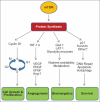Targeting mTOR pathway: A new concept in cancer therapy
- PMID: 21584218
- PMCID: PMC3089921
- DOI: 10.4103/0971-5851.76197
Targeting mTOR pathway: A new concept in cancer therapy
Abstract
This article highlights the current knowledge of mTOR biology and provides new insights into the role of mTOR in different cancers. An active mTOR coordinates a response in cell growth directly through its effects on cell cycle regulators and indirectly by sustaining nutrient supply into the cell through the production of nutrient transporters and also through the promotion of angiogenesis. A primary way that mTOR exerts its regulatory effects on cell proliferation is by controlling the production of cyclin D1. mTOR increases the translation of hypoxia-inducible factor 1 (HIF-1)/HIF-2. The HIF transcription factors drive the expression of hypoxic stress response genes, including angiogenic growth factors such as vascular endothelial growth factor (VEGF), platelet-derived growth factor β (PDGF-β), and transforming growth factor a (TGF-α). mTOR also increases the surface expression of nutrient transporters proteins. An increase in these proteins results in greater uptake of amino acids and other nutrients by the cell leading to adequate nutrient support to abnormal cell growth and survival. There is also emerging evidence that mTOR activation may play a role in promoting cell survival through the activation of antiapoptotic proteins that contribute to tumor progression. Given that the mTOR pathway is deregulated in a number of cancers, it is anticipated that mTOR inhibitors will have broad therapeutic application across many tumor types. Until now, no treatment demonstrated Phase III evidence after disease progression on an initial VEGF-targeted therapy in advanced renal cell carcinoma. Everolimus is the first and only therapy with Phase III evidence after failure of VEGF-targeted therapy. Everolimus is a once-daily, oral inhibitor of mTOR (mammalian target of rapamycin) indicated for the treatment of advanced renal cell carcinoma in patients, whose disease has progressed on or after treatment with VEGF-targeted therapy.
Keywords: Angiogenesis; bioenergetics; everolimus.
Conflict of interest statement
Figures
Similar articles
-
The vascular disrupting agent BNC105 potentiates the efficacy of VEGF and mTOR inhibitors in renal and breast cancer.Cancer Biol Ther. 2014;15(11):1552-60. doi: 10.4161/15384047.2014.956605. Cancer Biol Ther. 2014. PMID: 25482941 Free PMC article.
-
Curcumin Ameliorates Chronic Renal Failure in 5/6 Nephrectomized Rats by Regulation of the mTOR/HIF-1α/VEGF Signaling Pathway.Biol Pharm Bull. 2019 Jun 1;42(6):886-891. doi: 10.1248/bpb.b18-00787. Epub 2019 Mar 28. Biol Pharm Bull. 2019. PMID: 30918132
-
mTOR in renal cell cancer: modulator of tumor biology and therapeutic target.Expert Rev Mol Diagn. 2009 Apr;9(3):231-41. doi: 10.1586/erm.09.8. Expert Rev Mol Diagn. 2009. PMID: 19379082 Review.
-
Therapeutic strategy targeting the mTOR-HIF-1alpha-VEGF pathway in ovarian clear cell adenocarcinoma.Pathol Int. 2009 Jan;59(1):19-27. doi: 10.1111/j.1440-1827.2008.02320.x. Pathol Int. 2009. PMID: 19121088
-
Targeting mTOR in cancer: renal cell is just a beginning.Target Oncol. 2010 Dec;5(4):269-80. doi: 10.1007/s11523-010-0141-x. Epub 2010 Jun 20. Target Oncol. 2010. PMID: 20563661 Review.
Cited by
-
AZD2014 Radiosensitizes Oral Squamous Cell Carcinoma by Inhibiting AKT/mTOR Axis and Inducing G1/G2/M Cell Cycle Arrest.PLoS One. 2016 Mar 31;11(3):e0151942. doi: 10.1371/journal.pone.0151942. eCollection 2016. PLoS One. 2016. PMID: 27031247 Free PMC article.
-
Antitumor effect of the mTOR inhibitor everolimus in combination with trastuzumab on human breast cancer stem cells in vitro and in vivo.Tumour Biol. 2012 Oct;33(5):1349-62. doi: 10.1007/s13277-012-0383-6. Epub 2012 Apr 11. Tumour Biol. 2012. PMID: 22492237
-
Everolimus-induced epithelial to mesenchymal transition in immortalized human renal proximal tubular epithelial cells: key role of heparanase.J Transl Med. 2013 Nov 20;11:292. doi: 10.1186/1479-5876-11-292. J Transl Med. 2013. PMID: 24256696 Free PMC article.
-
Clinical and Pre-Clinical Evidence of Carbonic Anhydrase IX in Pancreatic Cancer and Its High Expression in Pre-Cancerous Lesions.Cancers (Basel). 2020 Jul 22;12(8):2005. doi: 10.3390/cancers12082005. Cancers (Basel). 2020. PMID: 32707920 Free PMC article. Review.
-
Hepatocellular carcinoma: important biomarkers and their significance in molecular diagnostics and therapy.Curr Med Chem. 2012;19(22):3722-9. doi: 10.2174/092986712801661059. Curr Med Chem. 2012. PMID: 22680921 Free PMC article. Review.
References
-
- Hay N, Sonenberg N. Upstream and downstream of mTOR. Genes Dev. 2004;18:1926–45. - PubMed
-
- Abraham RT, Gibbons JJ. The mammalian target of rapamycin signaling pathway: twists and turns in the road to cancer therapy. Clin Cancer Res. 2007;13:3109–14. - PubMed
-
- Dancey JE. Therapeutic targets: mTOR and related pathways. Cancer Biol Ther. 2006;5:1065–73. - PubMed
-
- Wullschleger S, Loewith R, Hall MN. TOR signaling in growth and metabolism. Cell. 2006;124:471–84. - PubMed
-
- Nelsen CJ, Rickheim DG, Tucker MM, Hansen LK, Albrecht JH. Evidence that cyclin D1 mediates both growth and proliferation downstream of TOR in hepatocytes. J Biol Chem. 2003;278:3656–63. - PubMed
LinkOut - more resources
Full Text Sources
Research Materials
Miscellaneous

